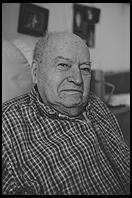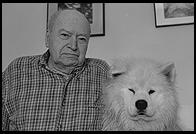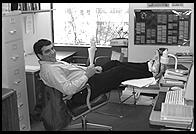
Canon EOS 50/1.8
by Philip Greenspun; created 1995
Site Home : Photography : Canon EOS 50/1.8
This lens has been replaced by the Canon EF 50/1.8 STM, which has similar optics and construction, but a much better autofocus motor
 This
is the lightest cheapest-feeling lens I've ever used on an SLR. It is
all plastic, right down to the lens mount. The optical performance of
the glass inside is fine, but manual focusing isn't much fun. Auto
focusing isn't much fun either, because this lens does not contain a
USM motor, but rather an
ancient Canon EOS lens motor. Because of this primitive motor,
simultaneous manual/auto focus isn't available with this lens.
This
is the lightest cheapest-feeling lens I've ever used on an SLR. It is
all plastic, right down to the lens mount. The optical performance of
the glass inside is fine, but manual focusing isn't much fun. Auto
focusing isn't much fun either, because this lens does not contain a
USM motor, but rather an
ancient Canon EOS lens motor. Because of this primitive motor,
simultaneous manual/auto focus isn't available with this lens.
 So why do I own this
lens? It costs only about $80. It is incredibly lightweight. It takes
vastly better pictures than a mid-range mid-priced zoom. It can take a
photo without flash in light that is one quarter as bright as the
light required by a consumer zoom (usually these have max apertures of
around f/4).
So why do I own this
lens? It costs only about $80. It is incredibly lightweight. It takes
vastly better pictures than a mid-range mid-priced zoom. It can take a
photo without flash in light that is one quarter as bright as the
light required by a consumer zoom (usually these have max apertures of
around f/4).
If you intend to use manual focus often, you'd be better off with the 50/1.4 USM, which is a much more modern design and has a wider manual focus ring. It also has the USM so that you can do simultaneous manual/auto focus, the best feature of the Canon EOS system (though Nikon has begun to compete with their S range of lenses).
Note: the Nikon 50/1.8 AF lens is also rather cheesy but it has a somewhat smoother and better-damped manual focus ring.
| Construction: | 6 elements, 5 groups |
|---|---|
| Angle of view: | 46 degrees (diagonal), 27 (vertical), 40 (horizontal) |
| Diaphragm Blades: | 5 |
| Focus motor: | cheap old-style AFD |
| Closest focusing: | 0.45 m (1.5 ft) |
| Filter size: | 52 mm |
| Lens Hood: | ES-62 (screw-in, not outside bayonet) |
| Length and diameter: | 41 x 68.2 mm |
| Weight: | 130 gm |
Text and pictures copyright 1995 Philip Greenspun